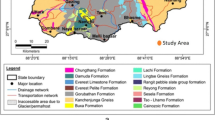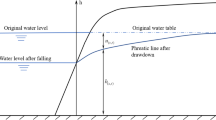Abstract
Slope failure is a widely observed phenomenon in the mountainous areas in Taiwan due to rainy climatic and fragile geological conditions. Landslides easily occur after intense rainfall, especially from typhoons, and, accordingly, cause a great loss of human life and property. At the northern end of the Western Foothill belt in northern Taiwan, Huafan University is founded on a dip-slope about 20° toward the southwest composed of early Miocene alternations of sandstone and shale. Data from continuous monitoring using inclinometers and groundwater gauges reveal that 6–10 mm/month of slope creeping occurs, and a potential sliding surface is then detected about 10–40 m beneath the slope surface. To understand the potential runout process of the dip-slope failure at the campus, particle flow code 3D models based on a discrete element method are applied in this study. Results of the simulation reveal a critical value of the friction coefficient to be 0.13 and that more than 90% of the campus buildings will slide down in 100 s when the friction coefficient is reduced to half the critical value. The weakening of the shear zone due to the rise of groundwater during rainstorms is assumed to be the main factor. Some suggestions for preventing landslide disasters are to construct catchpits to drain runoff and lower the groundwater table and to install a sufficient number of ground anchors and retaining walls to stabilize the slope.









Similar content being viewed by others
References
Chan Y-C, Chen Y-G, Shih T-Y, Huang C (2007) Characterizing the Hsingcheng active fault in northern Taiwan using airborne LiDAR data: detailed geomorphic features and their structural implications. J Asian Earth Sci 31:303–316
Chang K-J, Taboada A (2009) Discrete element simulation of the Jiufengershan rock-and-soil avalanche triggered by the 1999 Chi-Chi earthquake, Taiwan. J Geophys Res 114:F03003
Ching K-E, Hsieh M-L, Johnson KM, Chen K-H, Rau R-J, Yang M (2011) Modern vertical deformation rates and mountain building in Taiwan from precise leveling and continuous PS observations, 2000–2008. J Geophys Res 116(B08406):16
Crosta GB, Frattini P (2008) Rainfall-induced landslides and debris flows. Hydrol Process 22:473–477
Cundall PA (1971) A computer model for simulating progressive, large-scale movements in blocky rock systems. In: Proceedings of the international symposium on rock fracture, Nancy. Int. Soc. Rock Mech. (ISRM) 1(II–8):129–136
Cundall PA, Strack ODL (1979) A discrete numerical model for granular assemblies. Geotechnique 29(1):47–65
Dunnicliff J (1988) Geotechnical instrumentation for monitoring field performance. John Wiley, New York, p 577
Gullà G, Peduto D, Borrelli L, Antronico L, Fornaro G (2016) Geometric and kinematic characterization of landslides affecting urban areas: the Lungro case study (Calabria, Southern Italy). Landslides 13:1–18
Hsieh Y-C, Chan Y-C, Hu J-C (2016) Digital elevation model differencing and error estimation from multiple sources: a case study from the Meiyuan Shan landslide in Taiwan. Remote Sens 8(199):1–20
Huang C-S, Jeng C-J (2004) A supplementary geological survey and analysis of the Dalun area around the Huafan University. J Art Des Huafan Univ 1:59–70 (in Chinese)
Huising EJ, Gomes Pereira LM (1998) Errors and accuracy estimates of laser data acquired by various laser scanning systems for topographic applications. ISPRS J Photogramm Remote Sens 53:245–261
Hungr O, Fell R, Couture R, Eberhardt E (2005) Landslide risk management. Taylor & Francis Group, London, p 764
ISRM (1974) SM for determining shear strength. The complete ISRM suggested methods for rock characterization, testing and monitoring: 1974–2006. In: Ulusay R Hudson JA (eds) Suggested methods prepared by the Commission on Testing Methods, ISRM, Compilation arranged by the ISRM Turkish National Group, Kozan Ofset, Ankara
ISRM (1979) SM for determining the uniaxial compressive strength and deformability of rock materials. The complete ISRM suggested methods for rock characterization, testing and monitoring: 1974–2006. In: Ulusay R, Hudson JA (eds) Suggested methods prepared by the Commission on Testing Methods, ISRM, Compilation arranged by the ISRM Turkish National Group, Kozan Ofset, Ankara
Itasca, Consulting Group Inc. (2008) PFC3D particle flow code in 3 dimensions. User’s Guide, Minneapolis
Jeng C-J (2003) Study on slope stability mechanism of Huafan University by using of inclinometer displacement and limiting equilibrium stability analysis. J Huafan Univ 9:115–127 (in Chinese)
Jeng C-J, Sue D-Z (2016) Characteristics of ground motion and threshold values for colluvium slope displacement induced by heavy rainfall: a case study in northern Taiwan. Nat Hazards Earth Syst Sci 16:1309–1321
Jeng C-J, Hung C-S, Shieh C-Y (2008) Case study of the application of in situ geological mapping and 2D-resistivity image exploration for the slope in Huafan University (in Chinese). J Art Des Huafan Univ 4:166–180
Jibson RW (2007) Regression models for estimating coseismic landslide displacement. Eng Geol 91:209–218
Johnston IW (1993) Soft rock engineering. In: Hudson JA (ed) Comprehensive rock engineering, vol 1. Elsevier, New York, pp 367–393
Keefer DK (2000) Statistical analysis of an earthquake-induced landslide distribution—the 1989 Loma Prieta, California event. Eng Geol 58:231–249
Keefer DK, Larsen MC (2007) Assessing landslide hazards. Science 316:1136–1138
Lee Y-H, Chen C-C, Liu T-K, Ho H-C, Lu H-Y, Lo W (2006) Mountain building mechanisms in the Southern Central Range of the Taiwan orogenic Belt—from accretionary wedge deformation to arc-continental collision. Earth Planet Sci Lett 252(3–4):413–422
Liao R-T (2001) Engineering design of slope protection. Scientific & Technical Publishing Co., Ltd., Taipei, Taiwan: p. 224 (in Chinese; self translation)
Lin C-C (2000) Explanatory text of the geological map of Taiwan. Central Geological Survey of Taiwan. Hsintien, Sheet 32: p. 77 (in Chinese)
Lin M-L, Hung J-J (1982) The influence of moisture content on mechanical properties of some sedimentary rocks in Taiwan. In: Proceedings of the 7th Southeast Asian geotechnical conference, department of civil engineering, National Taiwan University, Taipei, Taiwan
Lo C-M, Lin M-L, Tang C-L, Hu J-C (2011) A kinematic model of the Hsiaolin landslide calibrated to the morphology of the landslide deposit. Eng Geol 123:22–39
Lo C-M, Huang W-K, Lin M-L (2016) Earthquake-induced deep-seated landslide and landscape evolution process at Hungtsaiping, Nantou County, Taiwan. Environ Earth Sci 75(8):16
Lu C-Y, Tang C-L, Chan Y-C, Hu J-C, Chi C-C (2014) Forecasting landslide hazard by the 3D discrete element method: a case study of the unstable slope in the Lushan hot spring district. Eng Geol 183:14–30
McDougall S, McKinnon M, Hungr O (2012) Developments in landslide runout prediction. In: Clague JJ, Stead D (eds) Landslides: types, mechanisms and modeling. Cambridge University Press, Cambridge, pp 187–195
Medina V, Hürlimann M, Bateman A (2008) Application of FLATModel, a 2D finite volume code, to debris flows in the northeastern part of the Iberian Peninsula. Landslides 5(1):127–142
Pirulli M, Mangeney A (2008) Results of back-analysis of the propagation of rock avalanches as a function of the assumed rheology. Rock Mech Rock Eng 41(1):59–84
Pirulli M, Sorbino G (2008) Assessing potential debris flow runout: a comparison of two simulation models. Nat Hazards Earth Syst 8:961–971
Poisel R, Preh A (2008) 3D landslide modelling using the particle flow code PFC3D. In: Chen Z, Zhang J, Li Z, Wu F, Ho K (eds). Proceedings of the 10th international symposium on landslides and engineered slopes. Taylor and Francis, London, pp 873–879
Poisel R, Roth W (2004) Run out models of rock slope failure. Felsbau 22:46–50
Stark TD, Choi H (2008) Slope inclinometers for landslides. Landslides 5(3):339–350
Steady D, Eberthardt E, Coggan JS (2006) Developments in the characterization of complex rock slope deformation and failure using numerical modelling techniques. Eng Geol 83:217–235
Tang C-L, Hu J-C, Lin M-L, Angelier J, Lu C-Y, Chan Y-C, Chu H-T (2009) The Tsaoling landslide triggered by the Chi-Chi earthquake, Taiwan: insights from a discrete element simulation. Eng Geol 106(1–2):1–19
Tang C-L, Hu J-C, Lin M-L, Yuan R-M, Cheng C-C (2013) The mechanism of the 1941 Tsaoling landslide, Taiwan: insight from a 2D discrete element simulation. Environ Earth Sci 70:1005–1019
Wang FW, Sassa K, Wang G (2002) Mechanism of a long-runout landslide triggered by the August 1998 heavy rainfall in Fakushima Prefecture, Japan. Eng Geol 63:169–185
Yeh C-H, Lin M-L, Chan Y-C, Chang K-J, Hsieh Y-C (2017) Dip-slope mapping of sedimentary terrain using polygon auto-tracing and airborne LiDAR topographic data. Eng Geol 222:236–249
Yen K-C (2000) Study on the relationship between residual strength of the Chinshui Shale and stability of the Tsaoling slope. Master’s Thesis, Department of Civil Engineering, National Taiwan University, Taipei, Taiwan, p 109 (in Chinese; self translation)
Acknowledgements
We would like to thank colleagues at the Institute of Earth Sciences, Academia Sinica, and Department of Geosciences, National Taiwan University, for technical help and valuable comments on this research. We would also like to thank Prof. Ruey-Juin Rau at the Department of Earth Sciences, National Cheng-Kung University, for providing the GPS devices and technical support for the future work in the study area. This study is supported by the Taiwan Ministry of Science and Technology funding MOST 105-2811-M-001-057 and MOST 105-2116-M-001-019.
Author information
Authors and Affiliations
Corresponding author
Rights and permissions
About this article
Cite this article
Tseng, CH., Chan, YC., Jeng, CJ. et al. Slip monitoring of a dip-slope and runout simulation by the discrete element method: a case study at the Huafan University campus in northern Taiwan. Nat Hazards 89, 1205–1225 (2017). https://doi.org/10.1007/s11069-017-3016-y
Received:
Accepted:
Published:
Issue Date:
DOI: https://doi.org/10.1007/s11069-017-3016-y




